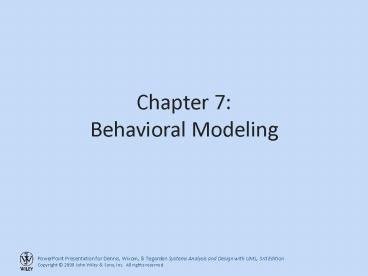Chapter 7: Behavioral Modeling - PowerPoint PPT Presentation
1 / 22
Title:
Chapter 7: Behavioral Modeling
Description:
CRUD ANALYSIS. CRUD Analysis. Labels object interaction in 4 possible ways. Create. Read ... Sample CRUD Matrix. Summary. Behavioral Models. Interaction ... – PowerPoint PPT presentation
Number of Views:115
Avg rating:3.0/5.0
Title: Chapter 7: Behavioral Modeling
1
Chapter 7Behavioral Modeling
2
Objectives
- Understand the rules and style guidelines for
sequence and communication diagrams and
behavioral state machines. - Understand the processes used to create sequence
and communication diagrams and behavioral state
machines. - Be able to create sequence and communication
diagrams and behavioral state machines. - Understand the relationship between the
behavioral models and the structural and
functional models.
3
Key Ideas
- Behavioral models describe the internal dynamic
aspects of an information system that supports
business processes in an organization - Key UML behavioral models are sequence diagrams,
collaboration diagrams, and statechart diagrams
4
Behavioral Models
5
Behavioral Models
- Systems have static dynamic characteristics
- Structural models describe the static aspects of
the system - Behavioral models describe the dynamics and
interactions of the system and its components - Behavioral models describe how the classes
described in the structural models interact in
support of the use cases.
6
Interaction Diagrams
7
Interaction Diagram Components
- Objects
- an instantiation of a class
- Operations
- the behaviors of an instance of a class
- Messages
- information sent to objects to tell them to
execute one of their behaviors
8
Sequence Diagrams
- Illustrate the objects that participate in a
use-case - Show the messages that pass between objects for a
particular use-case
9
Sequence Diagram Syntax
10
More Sequence Diagram Syntax
11
Sample Sequence Diagram
12
Steps to Build Sequence Diagrams
- Set the context
- Identify which objects will participate
- Set the lifeline for each object
- Lay out the messages from top to bottom of the
diagram based on the order in which they are sent - Add execution occurrence to each objects
lifeline - Validate the sequence diagram
13
Behavioral State Machines
14
Behavioral State Machines
- A dynamic model that shows the different states
through which a single object passes during its
life in response to events, along with its
responses and actions - Typically not used for all objects
- Just for complex ones
15
Components of State Machines
- States
- values of an objects attributes at a point in
time - Events
- change the values of the objects attributes
- Transitions
- movement of an object from one state to another
- Actions
- atomic, non-decomposable processes
- Activities
- non-atomic, decomposable processes
16
State Machine Syntax
17
Sample State Machine
18
Steps to Build a State Machine
- Set the context
- Identify the initial, final, and stable states of
the object - Determine the order in which the object will pass
through the stable states - Identify the events, actions, and guard
conditions associated with the transitions - Validate the behavioral state machine
19
CRUD Analysis
20
CRUD Analysis
- Labels object interaction in 4 possible ways
- Create
- Read
- Update
- Delete
- Matrix representation of objects and interactions
- Most useful as a system-wide representation
21
Sample CRUD Matrix
22
Summary
- Behavioral Models
- Interaction Diagrams
- Behavioral State Machines
- CRUD Analysis































